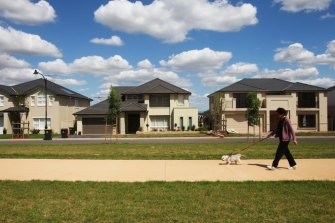Rapidly rising property prices have led to increasing concerns around affordability, but support for government intervention may actually decline as affordability worsens, a new paper suggests.
Authors of the study argue that homeowners seek to protect their property price gain from being taxed away or undermined by growing housing supply, resulting in less support for government intervention in housing market inequality.

While based on European data, local experts and economists say it points to the challenge of rolling out reforms to improve housing affordability when more people, and voters, are homeowners than not.
Grattan Institute household finances program director Brendan Coates said the politics of improving housing affordability was fraught because most voters already owned a house or investment and mistrust any change that might dent property prices.
“The interest of homeowners tends to outweigh the interest of renters. There’s that classic adage from John Howard who [as prime minister] said that no one is complaining in the streets about their house value going up,” Mr Coates said.
The political consequences of housing (un)affordability, published in The Journal of European Social Policy earlier this month, used data drawn from European and British social surveys and an analysis of British elections to explore the relationship between housing affordability – house prices relative to incomes – and the demand for redistributive and housing policy.
Authors Ben Ansell, a professor at Nuffield College and the University of Oxford, and Asli Cansunar, an assistant professor at the University of Washington, found consistent evidence that declining affordability, driven by increasing house prices, decreases support for interventionist housing policy, especially among homeowners across Europe, and increased votes for the conservative party in the UK.
The beneficiaries of unaffordability, who they noted were those who own property, will prefer to keep policies and parties in place that keep prices high and rising, they concluded. However, while citizens on aggregate become less supportive of intervention, this masked a growing polarisation in preferences between renters and owners in less affordable regions.
Mr Coates said the research design was plausible in the European context, and that poor affordability would likely impact the preferences of political constituents. However, it was not clear if the politics would play out the same way in Australia, noting that at the last election, when Labor was promising changes to negative gearing and the capital gains tax discount, the electorates that swung to Labor tended to be those of higher income earners, while lower income electorates swung toward the Coalition.
However, Mr Coates also noted it was inner city working-class suburbs that had won big in the “housing lottery” as prices climbed over the years, as they were the group with the largest share of their wealth in housing, while the wealth of higher income earners was typically more diversified.

Mr Coates added there was a clear trend in Australia, though, of wealthier areas being more resistant to increased housing supply, but this was driven by multiple factors and not just potential concern of downward pressure on property prices.
“The real question in the Australian context, where there are clearly more house owners than renters making housing policy transformation really hard, is whether there is enough interest from baby boomers … sufficiently worried about whether their kids can ever buy, that leans them more to reform.
“Or whether the solution [they reach] is to double down … by giving [their children] more access to the bank of mum and dad [to get into the market].”
Mr Coates said both tax reform and increased supply would be key to improving housing affordability in Australia, and worried about staunch proponents of either approach downplaying the other at the current inquiry into housing affordability and supply in Australia, when both were clearly needed.
Independent economist Saul Eslake said supply side reforms were only part of the solution and the federal government needed to back away from policies that inflate housing demand, and had been pursued by both sides of government, such as first-home buyer grants, negative gearing and the capital gains tax discount.
It was a tragedy that Labor had walked away from proposed changes to negative gearing and the capital gains tax, he noted, with the opportunity for such reform now possibly gone for a generation.
A greater focus on building more social housing was also needed, with both parties allowing the proportion of such housing to decline egregiously over the decades.
Appearing before the affordability inquiry last month, he asked members of the committee whose interests they were most concerned about: the 11 million Australians who already own at least one property, and the more than two million who own more than one, or the minority, albeit a growing minority, who have been unable to buy. He noted their answer would determine what they recommended to Parliament, with their report expected early in 2022.

Mr Eslake said while politicians shed “crocodile tears” for young Australians struggling to get onto the property ladder, there was a huge gulf between what they say and do. However, Mr Eslake, who also referenced Howard’s comments, acknowledged most homeowners did not want to see government action that would stop the value of their property going up.
“There is a very large constituency that is resolutely opposed to anything that would dampen the rate of house price inflation, yet that is surely at the heart of what you have to do if you’re going to solve the affordability issue.”
Mr Eslake said it was unclear if Australians had become any more opposed to redistribution policy as affordability declined, but noted that while Australia had quite a progressive income tax transfer system, wealth was taxed very lightly compared to other countries.
Any polarisation in preferences between renters and owners was less obvious locally, Mr Eslake added, saying he was often surprised that there was not more anger from young Australians about the way in which the market has been rigged against them by their parents’ generation. But even if they were to adapt their voting behaviour, he said, who would they vote for, with no big reforms on the table from either party.
The last federal election showed the concern homeowners had for housing reform.
Economist Jim Stanford, director of The Australia Institute’s Centre for Future Work, said that in the context of declining housing affordability it made sense for homeowners to be more cautious about their future and reforms, as they could feel more insecure in their situation, but was sceptical of the paper’s suggestion that they had benefited from unaffordability, noting few could sell off property without needing to buy elsewhere.
Many would also worry about their children and see that their kids did not “have a hope in hell” of buying a decent property, if poor affordability continued.
“I don’t think they are better off, even middle-class homeowners would be better off with a policy that thought of a housing as a more basic service. I don’t accept that they have made money off this boom [and just want] to continue to,” he said.
However, the last federal election had shown the concern homeowners had for housing reform, Dr Stanford said, noting that rightly or wrongly, those who saw themselves as housing investors could be influenced by scare campaigns against policies that made a lot of sense, like Labor’s proposed change to negative gearing.
“The government tried to portray it as a tax on homeowners, which is nonsense, but given how the election unfolded everyone is going to be curious about what they propose in this election, that experience sort of ratified the point … with this article.”
Dr Stanford said a big part of the solution would be building up Australia’s supply of non-market housing, which governments had basically walked away from over the last generation, with the time right for an ambitious plan to build more social and affordable housing.





